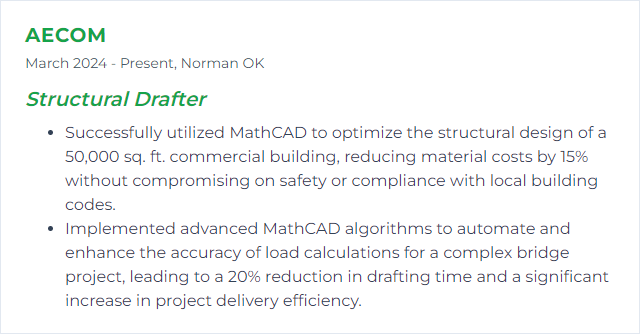Top 12 Structural Drafter Skills to Put on Your Resume
In the competitive field of structural drafting, showcasing a compelling set of skills on your resume can significantly enhance your marketability to potential employers. This article provides a curated list of the top 12 skills that can make your resume stand out, helping you to secure your position in this dynamic industry.
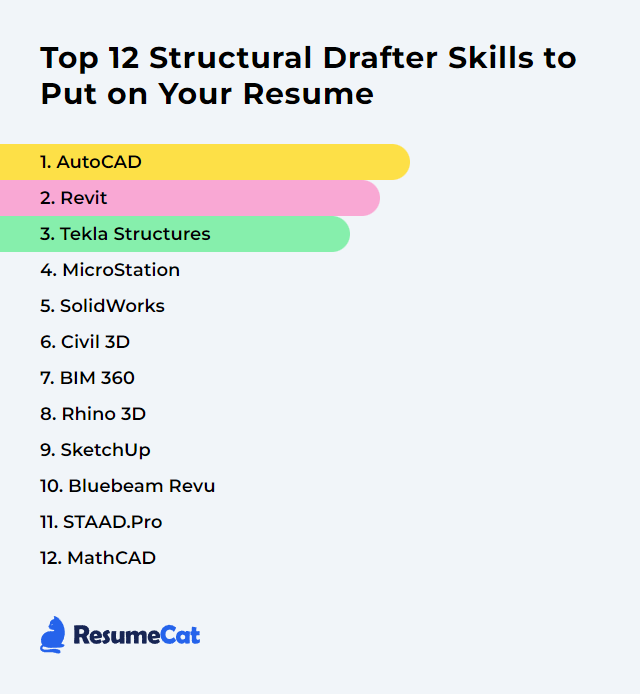
Structural Drafter Skills
- AutoCAD
- Revit
- Tekla Structures
- MicroStation
- SolidWorks
- Civil 3D
- BIM 360
- Rhino 3D
- SketchUp
- Bluebeam Revu
- STAAD.Pro
- MathCAD
1. AutoCAD
AutoCAD is a computer-aided design (CAD) software used by structural drafters to create precise 2D and 3D drawings and models of structures.
Why It's Important
AutoCAD is crucial for a Structural Drafter as it facilitates precise and efficient creation, modification, and analysis of complex structures, enhancing accuracy, productivity, and collaboration in the design process.
How to Improve AutoCAD Skills
Improving your AutoCAD skills as a Structural Drafter involves focusing on efficiency, accuracy, and advanced drafting techniques. Here's a concise guide:
Master Keyboard Shortcuts: Increase speed and efficiency by mastering AutoCAD keyboard shortcuts. Autodesk provides a comprehensive list.
Use AutoLISP & Scripts: Automate repetitive tasks and customize commands through AutoLISP. Start learning with Autodesk's AutoLISP tutorial.
Utilize Dynamic Blocks: Save time by using dynamic blocks for repetitive elements. Autodesk's dynamic blocks tutorial can get you started.
Explore 3D Modeling: Enhance your drafting capabilities by incorporating 3D modeling into your workflow. Learn more through the official AutoCAD 3D tutorial.
Stay Updated with New Features: Autodesk frequently updates AutoCAD with new features and enhancements. Keep up to date with the latest features by checking the official AutoCAD blog.
Participate in Online Forums and Communities: Engage with other professionals for tips, advice, and solutions. The Autodesk forums are a great place to start.
Continuous Learning: Enroll in advanced AutoCAD courses focused on structural drafting. Websites like LinkedIn Learning and Udemy offer specialized courses.
By integrating these resources and strategies into your practice, you can significantly enhance your proficiency and productivity in AutoCAD as a Structural Drafter.
How to Display AutoCAD Skills on Your Resume
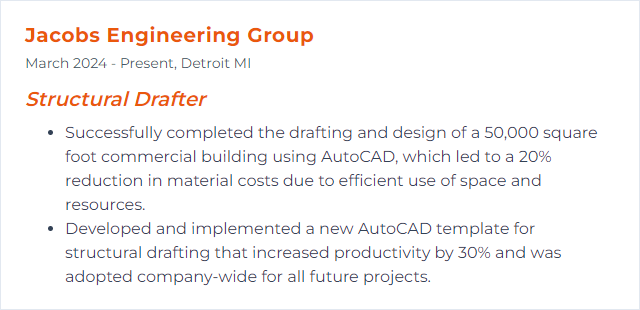
2. Revit
Revit is a Building Information Modeling (BIM) software tool used by professionals in the field of architecture, engineering, and construction for designing and documenting building structures, including creating detailed 3D structural models and generating construction documents. For a Structural Drafter, it facilitates the creation, visualization, and modification of structural components of buildings, enabling efficient drafting, analysis, and coordination of building structures.
Why It's Important
Revit is crucial for a Structural Drafter as it offers integrated tools for designing, analyzing, and documenting building structures within a collaborative BIM (Building Information Modeling) environment, enhancing accuracy, efficiency, and coordination.
How to Improve Revit Skills
Improving your Revit skills as a Structural Drafter involves both enhancing your proficiency with the software's tools and integrating best practices for efficient workflow. Here are concise tips along with useful resources:
Master the Basics: Start with mastering fundamental Revit Structural tools and commands. Autodesk’s own tutorials provide a solid foundation.
Utilize Templates and Standards: Develop or adopt standard templates and families specific to structural drafting. This guide on creating and using BIM standards is helpful.
Learn from Projects: Analyze and learn from existing projects. Websites like BIMsmith offer free Revit families and projects.
Advanced Training: Take advantage of advanced training courses and certifications. LinkedIn Learning offers Revit Structural courses tailored to different skill levels.
Stay Updated: Always stay updated with the latest Revit versions and features. The Autodesk Blog is a great resource for news and updates.
Join Forums and Groups: Engage with the community through forums and groups. The Autodesk Community is a place to share knowledge and solve problems together.
Practice Efficient Modeling: Focus on efficient modeling techniques such as proper use of families, parametric modeling, and utilizing Revit shortcuts. This Revit Pure post discusses creating an efficient structural Revit template.
Incorporate Add-Ons and Tools: Leverage third-party add-ons and tools for structural analysis and detailing. The Autodesk App Store offers a variety of Revit-compatible tools.
Improving your skills in Revit as a Structural Drafter is a continuous process of learning, practicing, and staying abreast of the latest advancements in the field.
How to Display Revit Skills on Your Resume

3. Tekla Structures
Tekla Structures is a comprehensive 3D building information modeling (BIM) software that allows structural drafters to create, manage, and detail complex structural designs, from conceptual planning to fabrication, construction, and maintenance. It supports a wide range of materials and includes tools for structural steel, precast concrete, and reinforced concrete designs.
Why It's Important
Tekla Structures is crucial for a Structural Drafter as it provides precise and highly detailed 3D modeling capabilities, enabling the creation of accurate construction drawings, reports, and material lists, thus improving the efficiency and accuracy of structural drafting projects.
How to Improve Tekla Structures Skills
Improving your skills in Tekla Structures as a Structural Drafter involves focusing on efficiency, accuracy, and continuous learning. Here are concise tips and resources:
Master the Basics: Ensure you have a solid foundation. Tekla offers official training courses tailored to different skill levels.
Customize Workspaces: Tailor your workspace for efficiency. Learn how to customize toolbars and commands through the Tekla User Assistance portal.
Use Keyboard Shortcuts: Increase speed and efficiency by mastering Tekla's keyboard shortcuts.
Leverage Templates and Reports: Automate documentation by utilizing and customizing templates and reports. The Template Editor Documentation provides guidance.
Engage with the Community: Join forums and discussion groups such as the Tekla Discussion Forum to learn from peers and share experiences.
Stay Updated: Regularly update your software and explore new features. Keep an eye on the What’s New section for the latest updates.
Practice Regularly: Like any software, proficiency comes with practice. Set aside time weekly to explore new tools and techniques.
By focusing on these areas and utilizing the provided resources, you can significantly improve your proficiency and efficiency in Tekla Structures as a Structural Drafter.
How to Display Tekla Structures Skills on Your Resume
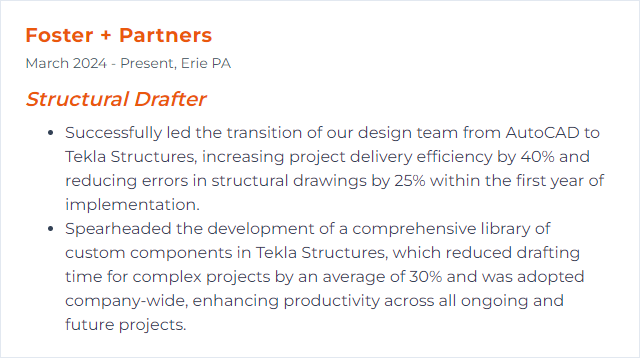
4. MicroStation
MicroStation is a computer-aided design (CAD) software developed by Bentley Systems, used for drafting and modeling in various engineering fields, including structural design. It enables structural drafters to create precise 2D and 3D drawings and models of buildings, bridges, and other structures, facilitating the visualization, simulation, and documentation of structural projects.
Why It's Important
MicroStation is important for a Structural Drafter because it provides advanced modeling, drafting, and detailing capabilities to accurately design, visualize, and document complex structures, ensuring precision and efficiency in the structural engineering workflow.
How to Improve MicroStation Skills
Improving your proficiency in MicroStation as a Structural Drafter involves enhancing both your technical skills and your understanding of the software's capabilities. Here are concise tips and resources to help you:
Master the Basics: Ensure you have a strong grasp of MicroStation's fundamental tools and features. Bentley Systems offers official training and tutorials which are an excellent starting point.
Utilize References and Models: Learn how to efficiently use reference attachments and models. This Reference Models guide can be a helpful resource.
Customize Your Workspace: Tailor your workspace and tool settings to suit your specific drafting needs. This can significantly boost your productivity. Bentley Communities provide insights on customization.
Learn Advanced Features: Dive into advanced features relevant to structural drafting, such as complex modeling, parametric modeling, and structural analysis integration. The MicroStation User Guide is a comprehensive resource.
Stay Updated: Keep up with the latest updates and features in MicroStation. Bentley Systems’ news and updates page can keep you informed about the latest developments.
Join Forums and Communities: Engaging with other professionals through forums and communities can provide valuable insights and solutions to common drafting challenges. The MicroStation Forum is a good place to start.
Practice: Regularly applying what you learn through projects or practice sessions will solidify your skills. Set aside time for personal projects or experiments with new tools and techniques.
Feedback and Peer Review: Seek feedback from peers and superiors on your work. Constructive criticism can highlight areas for improvement that you might have overlooked.
By focusing on these areas and leveraging the provided resources, you can significantly enhance your capabilities in MicroStation as a Structural Drafter.
How to Display MicroStation Skills on Your Resume
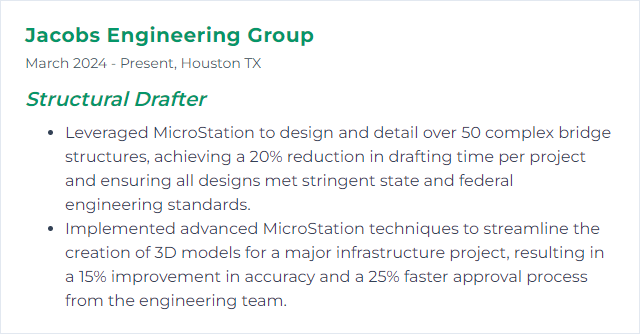
5. SolidWorks
SolidWorks is a computer-aided design (CAD) and engineering software widely used by structural drafters for creating detailed 3D models and drawings of structural components and systems, facilitating the visualization, simulation, and planning of structural projects.
Why It's Important
SolidWorks is vital for a Structural Drafter because it offers robust 3D modeling capabilities, enabling the efficient creation, simulation, and modification of complex structures, ensuring accuracy, and facilitating collaboration through easily shareable designs.
How to Improve SolidWorks Skills
Improving your SolidWorks skills as a Structural Drafter involves several focused strategies. Here's a concise guide to help you enhance your proficiency:
SolidWorks Tutorials: Start with the built-in tutorials in SolidWorks. They cover basic to advanced topics specifically designed to improve your understanding and efficiency. SolidWorks Tutorials
Practice Regularly: Consistent practice is key. Try recreating complex structures or parts from your field to challenge your skills.
Online Courses: Consider enrolling in online courses that focus on SolidWorks for structural design. Websites like LinkedIn Learning and Udemy offer courses tailored to different skill levels.
Certification: Aim for SolidWorks certification like the Certified SolidWorks Professional (CSWP) or the Certified SolidWorks Associate (CSWA). It's a great way to validate your skills. SolidWorks Certification
Join Forums and Communities: Engage with online communities such as the SolidWorks Forums or Reddit’s r/SolidWorks. They can be invaluable resources for tips, tricks, and troubleshooting.
Utilize Add-Ins: Explore and use SolidWorks add-ins specific to structural drafting and analysis, such as SolidWorks Simulation, to enhance your workflow and productivity.
Stay Updated: Keep your SolidWorks knowledge up to date by following the SolidWorks Blog and attending webinars or SolidWorks World conferences.
By integrating these strategies into your learning routine, you'll significantly improve your SolidWorks skills as a Structural Drafter.
How to Display SolidWorks Skills on Your Resume

6. Civil 3D
Civil 3D is a civil engineering design and documentation software that supports Building Information Modeling (BIM) workflows, primarily used for designing infrastructure projects like roads, land development, and water projects. For a Structural Drafter, it aids in creating detailed 3D models, generating precise drawings, and integrating structural elements within civil infrastructure designs.
Why It's Important
Civil 3D is important for a Structural Drafter as it provides advanced tools for precise design and analysis of infrastructure components, enables efficient creation of detailed 3D models for visualization and simulation, and facilitates seamless collaboration with other professionals by integrating with BIM workflows, enhancing accuracy, efficiency, and project outcomes.
How to Improve Civil 3D Skills
Improving your skills in Civil 3D, especially as a Structural Drafter, involves a combination of training, practice, and leveraging resources. Here are concise steps to enhance your proficiency:
Training Courses: Enroll in Autodesk's official training courses to understand foundational and advanced concepts.
Tutorials and Webinars: Watch tutorials and webinars on platforms like YouTube and LinkedIn Learning for practical tips and techniques.
User Community: Join the Autodesk Community to exchange ideas, solutions, and get advice from experienced professionals.
Practice Projects: Apply your skills on practical projects. Websites like GrabCAD offer project files you can practice with.
Customization: Learn to customize tool palettes and templates to streamline your work. Autodesk’s knowledge network provides guides on customization.
Software Updates: Stay updated with the latest versions and features of Civil 3D by checking Autodesk’s official site.
Feedback Loop: Use the feedback mechanisms within Civil 3D to suggest improvements or report issues directly to Autodesk, fostering a software environment that caters better to structural drafting needs.
By systematically following these steps, you can significantly improve your Civil 3D skills in a structural drafting context.
How to Display Civil 3D Skills on Your Resume
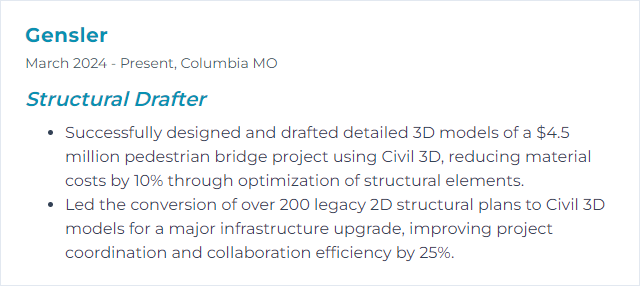
7. BIM 360
BIM 360 is a cloud-based platform designed for construction management, enabling project teams, including structural drafters, to collaborate in real-time on building projects, share documentation, and review 3D models, enhancing efficiency and accuracy in the drafting and design process.
Why It's Important
BIM 360 is important for a Structural Drafter as it enables efficient collaboration, real-time access to project data, and streamlined workflows, ensuring accurate and up-to-date structural designs within a unified platform.
How to Improve BIM 360 Skills
Improving BIM 360 for a Structural Drafter involves leveraging its collaboration, model coordination, and data management capabilities. Here are concise strategies:
Utilize Collaboration for Revit (C4R): Enhance real-time collaboration across project teams by using Collaboration for Revit (C4R), allowing for simultaneous contributions to models.
Implement Model Coordination: Use BIM 360 Model Coordination for clash detection and coordination meetings, reducing errors and rework.
Standardize Templates and Libraries: Create and share standardized templates and component libraries to ensure consistency and efficiency across projects.
Leverage Training Resources: Improve skills by utilizing Autodesk’s training and support resources, including tutorials and forums for best practices exchange.
Adopt Best Practices for Data Management: Organize and manage project data effectively using BIM 360’s Document Management feature, ensuring easy access and version control.
Feedback and Customization: Regularly provide feedback for BIM 360 improvements and customize the workspace to fit the specific needs of structural drafting projects.
By focusing on these strategies, a Structural Drafter can significantly enhance the efficiency and productivity of BIM 360 usage.
How to Display BIM 360 Skills on Your Resume
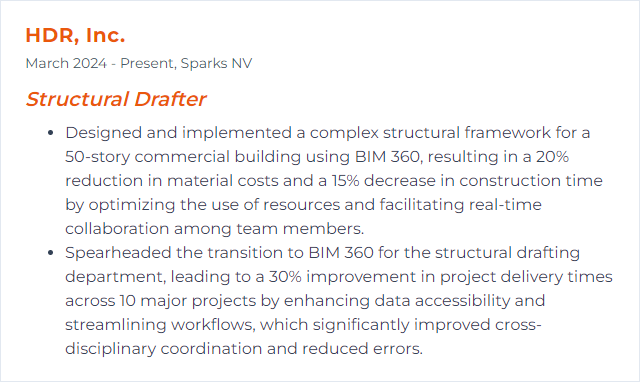
8. Rhino 3D
Rhino 3D is a versatile 3D modeling software used for creating, editing, and analyzing complex geometries, often utilized by structural drafters for precise modeling of structures, components, and assemblies, enhancing visualization, design, and engineering processes.
Why It's Important
Rhino 3D is important for a Structural Drafter because it offers versatile and precise modeling capabilities, enabling the creation of complex structures and geometries with high accuracy, supporting efficient drafting and design processes.
How to Improve Rhino 3D Skills
Improving your proficiency in Rhino 3D, especially from the perspective of a Structural Drafter, involves enhancing both your software skills and understanding of structural drafting principles. Here's a concise guide:
Master Rhino Basics: Start with the official Rhino Learn page for fundamental tutorials and exercises.
Utilize Plugins for Structural Design: Explore plugins like Karamba3D for structural analysis and Grasshopper for algorithmic modeling, which are powerful tools for structural drafters.
Participate in Online Forums and Communities: Join forums such as Rhino Community to exchange ideas, solutions, and get feedback from experienced users.
Practice with Real-World Projects: Apply your skills to real-world structural drafting projects, incrementally increasing complexity to build confidence and proficiency.
Continuous Learning and Updating: The field is always evolving, so stay updated with the latest Rhino versions and structural design trends by subscribing to Rhino Blog.
By focusing on these areas, you can significantly improve your Rhino 3D skills in the context of structural drafting.
How to Display Rhino 3D Skills on Your Resume
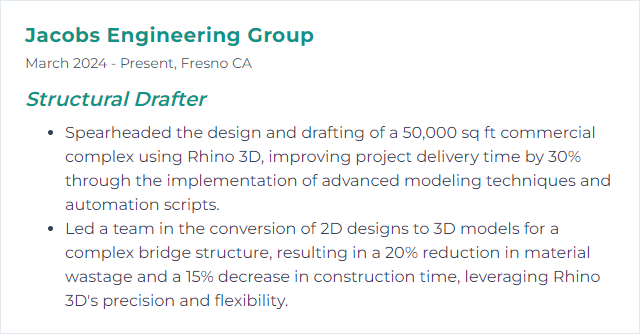
9. SketchUp
SketchUp is a 3D modeling software used for various drawing applications, including architectural, interior design, landscape architecture, and structural drafting. It enables structural drafters to create, visualize, and modify their designs in three dimensions, facilitating the planning and communication of structural details and layouts.
Why It's Important
SketchUp is important for a Structural Drafter as it offers an intuitive, easy-to-learn 3D modeling platform for creating detailed structural designs quickly, facilitating visualization, planning, and communication of complex structures with precision and efficiency.
How to Improve SketchUp Skills
To improve your SketchUp skills as a Structural Drafter, focus on mastering the following areas:
Learn the Basics: Start with SketchUp's own tutorials to understand the fundamentals thoroughly.
Use Extensions: Enhance functionality with structural drafting-specific extensions from the SketchUp Extension Warehouse. Notable ones include "1001bit Tools" for architectural elements and "Medeek Structural" for more detailed structural components.
Practice Precision Modeling: Understand how to use SketchUp's inferencing system. This SketchUp blog post offers tips on modeling speed and accuracy.
Explore SketchUp for Professionals: SketchUp's professional version offers advanced features suitable for structural drafting, like improved 3D modeling tools and integration with other CAD software.
Join Forums: Engage with the SketchUp Community Forum to exchange tips with other professionals and solve specific drafting challenges.
Continuous Learning: Stay updated with the latest features and best practices by following reputable SketchUp tutorial channels on platforms like YouTube.
By focusing on these areas, you can significantly enhance your proficiency in SketchUp for structural drafting tasks.
How to Display SketchUp Skills on Your Resume

10. Bluebeam Revu
Bluebeam Revu is a software application designed for markup, editing, and collaboration on construction documents, offering specialized tools for structural drafters to efficiently create, annotate, and share detailed technical drawings.
Why It's Important
Bluebeam Revu is important for a Structural Drafter because it streamlines the review, markup, and collaboration process on structural drawing sets, enhancing accuracy, efficiency, and project communication.
How to Improve Bluebeam Revu Skills
To improve your experience with Bluebeam Revu as a Structural Drafter, consider the following concise tips:
Customize Tool Sets: Tailor tool sets specifically for structural drafting tasks for faster annotation and markup. Bluebeam Tool Sets Guide.
Utilize Layers: Organize your markups and annotations on separate layers for different structural elements for easier navigation and editing. Bluebeam Layers Tutorial.
Master Keyboard Shortcuts: Increase your drafting speed by learning and using Bluebeam's keyboard shortcuts. Keyboard Shortcuts Guide.
Leverage Templates: Create or utilize existing templates for common structural drafting documents to save time. Using Templates in Bluebeam.
Batch Processing: Use the Batch Processing feature for tasks like hyperlinking, slip sheeting, and stamping across multiple documents. Batch Processing Overview.
Attend Training Sessions: Bluebeam offers webinars and training tailored to various professions, including structural drafting, to enhance your skills. Bluebeam Training.
Participate in Bluebeam Communities: Join Bluebeam communities or forums to exchange tips with other professionals. Bluebeam Community.
Implementing these strategies will help streamline your workflow, enhance the quality of your structural drafting projects, and maximize your efficiency in Bluebeam Revu.
How to Display Bluebeam Revu Skills on Your Resume
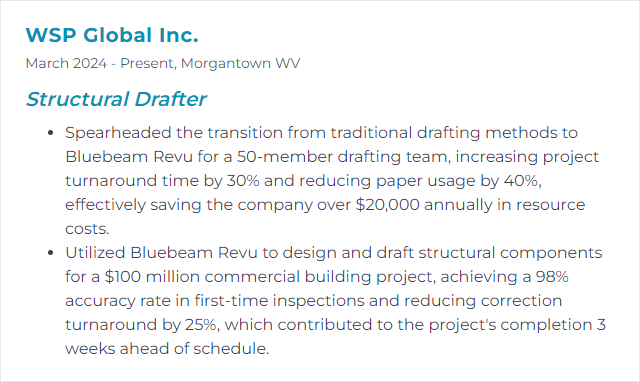
11. STAAD.Pro
STAAD.Pro is a structural analysis and design software widely used by structural drafters and engineers to model, analyze, and design various types of structures, including buildings, bridges, towers, and industrial facilities. It helps in creating efficient and robust designs by simulating the structural behavior under different loads, ensuring compliance with international design codes.
Why It's Important
STAAD.Pro is crucial for a Structural Drafter as it streamlines the analysis and design of structures, ensuring accuracy, efficiency, and compliance with international standards, thus enhancing the quality and productivity of drafting projects.
How to Improve STAAD.Pro Skills
Improving your STAAD.Pro skills as a Structural Drafter involves a mix of learning, practice, and leveraging the right resources. Here's a concise guide:
Understand the Basics: Ensure a strong grasp of fundamental structural engineering concepts and how they apply within STAAD.Pro. Bentley Systems offers a comprehensive guide to get started.
Explore Bentley Learning: Bentley's Learning Website provides specific courses and training materials for STAAD.Pro, enhancing your technical skills.
Practice Regularly: Apply what you've learned in real-world scenarios or through sample projects offered by Bentley. Practice is crucial to mastering STAAD.Pro.
Join Forums: Engage with the Bentley Communities to ask questions, share knowledge, and learn from experienced users.
Stay Updated: Keep abreast of the latest features and updates in STAAD.Pro by regularly checking the official STAAD.Pro page and subscribing to Bentley newsletters.
Utilize YouTube Tutorials: YouTube is a valuable resource for visual learners. Channels like Structure Engineering provide step-by-step tutorials on specific functions and tasks in STAAD.Pro.
Read Manuals and Documentation: Bentley’s detailed manuals and documentation offer insights into every aspect of STAAD.Pro, from basic operations to advanced features.
Experiment with Advanced Features: As you grow more comfortable, begin experimenting with STAAD.Pro’s advanced features to solve more complex structural problems and improve your drafting and modeling skills.
By following these steps and actively seeking out new learning opportunities, you'll significantly improve your STAAD.Pro skills and become a more proficient Structural Drafter.
How to Display STAAD.Pro Skills on Your Resume

12. MathCAD
MathCAD is a computer software used for solving, analyzing, and sharing engineering calculations. It's particularly useful for a Structural Drafter as it allows for easy manipulation and documentation of structural calculations, integrating them seamlessly into design workflows.
Why It's Important
MathCAD is important for a Structural Drafter because it allows for the efficient and accurate calculation of structural loads, stress analysis, and dimensioning, integrating mathematical equations with visual representations, thereby ensuring structural integrity and compliance with engineering standards.
How to Improve MathCAD Skills
Improving your MathCAD experience as a Structural Drafter involves enhancing both your proficiency with the software and its integration into your drafting workflow. Here are concise steps and resources to help you achieve this:
Master the Basics: Ensure you have a solid foundation in MathCAD basics. Start with PTC’s MathCAD tutorials for structured learning.
Customize Your Workspace: Tailor MathCAD’s interface to suit structural drafting needs by customizing toolbars and creating templates for repetitive tasks. This guide outlines customization options.
Advanced Functions for Structural Drafting: Dive into advanced features and functions relevant to structural drafting. Utilize MathCAD’s advanced calculation capabilities for structural analysis.
Integration with CAD Software: Leverage MathCAD’s ability to integrate with CAD software for a seamless workflow. Explore resources on integrating MathCAD with CAD tools for efficient design and drafting.
Use MathCAD Prime for Collaboration: Adopt MathCAD Prime to improve collaboration among your team by sharing calculations and designs easily. Check out the collaboration features of MathCAD Prime.
Stay Updated and Continuous Learning: Keep your skills sharp and stay updated with the latest MathCAD features and updates. Join the MathCAD Community for tips, tricks, and updates.
By focusing on these key areas, you can significantly enhance your MathCAD skills and its application in structural drafting, leading to more efficient and accurate work.
How to Display MathCAD Skills on Your Resume
